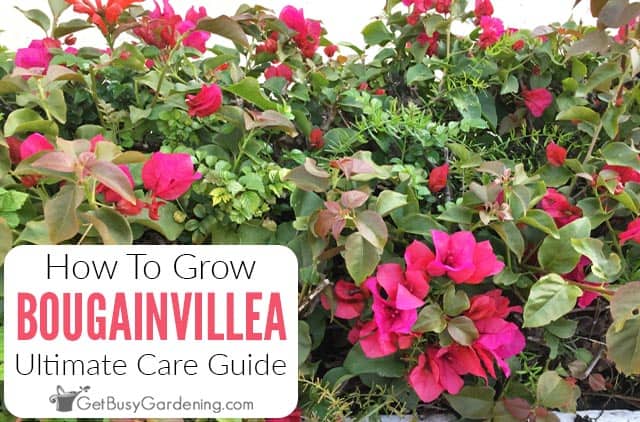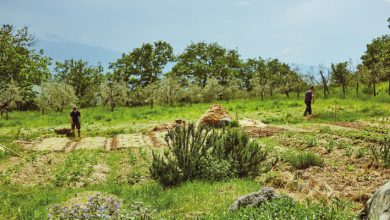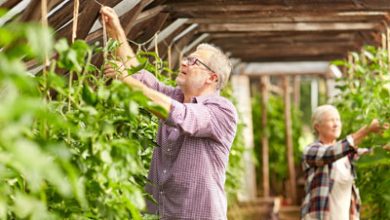Plant Bougainvillea or Bugambilia in your Garden: [Complete Guide]

The bugambilia or bougainvillea (Bougainvillea)It can grow both in the form of a vine and a bush since its branches can measure from one meter to twelve meters in length.
If your purpose is to grow on the walls, you can help it by placing wires and from there it will extend its branches.
It is native to South America, mainly from countries such as Brazil, Peru, and Argentina. And it can also be considered a fast-growing plant.
Important Points when Planting Bugambilia:
- When? It is preferable in spring, because it does not like the cold.

- Where? It needs a lot of sunlight and slightly warm temperatures (15ºC – 20ºC).
- Growing time? With water and well-nourished soil, the Bugambilia grows very fast.
- How do we prepare the soil? Fertile and well drained soils. With a pH between 5 and 6. It does not like clay-type soils.
- How do we water? Ideal, drip irrigation.
- How often do we water? At first, if it is hot, it is necessary to water 3 times a week. When it has grown enough, rainwater can suffice, except in summers with very high temperatures.
- How is it planted? We can do it from seed (easier, but slower) or by cutting (faster, but more complicated).
- What pests and diseases does it have? Mainly mildew. Although it can also be attacked by red spider, white fly or aphid.
Description of Bougainvillea
 The Bougainvillea have small thorns characteristic of their genus.
The Bougainvillea have small thorns characteristic of their genus.
Most of its types have purple leaves or varieties of this, although you can also find beige or yellow.
They are quite delicate leaves, opposite each other and with a pointed end. In the center of each set of petals stands out a little flower (sometimes there can be up to three) of a white color and a very small tubular appearance, but which as a whole is quite showy.
The other leaves that do not protect the flower are green, generally with strong shades. They end in a point and are a little wavy. They can measure between 4 to 12 centimeters long depending on the climatic conditions where it develops.
Important: Plan well where you want to plant the bougainvillea because it grows a lot and quickly. So it can consume resources such as light or land from other plants. Did you know…Is bougainvillea an ideal plant if we want to set up our own vertical garden?
Also, one ofthe advantages of planting bougainvilleain your garden is that you will have at hand a plant with medicinal properties.
It is normally consumed in the form of tea to treat problems related to the respiratory tract such as flu, cough, asthma and bronchitis.
Likewise, due to its antiseptic properties, it can be used as a treatment for skin problems such as acne or simply to care for it.
It can be considered a hanging plant, such as wisteria.
When to plant bougainvillea? The dates
 The best time to plant bougainvilleait is in springsince the winter season has passed.
The best time to plant bougainvilleait is in springsince the winter season has passed.
It is a shrub related to heat, so at the beginning of its growth it is better to provide it with the necessary conditions so that it develops in the best way.
It is currently present throughout the world in areas of humid tropical forests. Although it can also grow in subtropical climates. They can grow in slightly more extreme climates but the flowering period will decrease a bit.
Likewise, it develops in slightly dry climates, butwith temperatures not lower than 15°C.
If you live in an area with very cold winters, you can protect it with mesh or inside your house if you planted it in a pot.
Where to plant bougainvillea? light and temperature
Regarding temperature and light requirements, the Bougainvillea requiresdaily sun exposure.
It is recommended thatbe about six hoursso that the leaves can have quite an eye-catching pigment.
The most recommended temperature is between 18 to 38°C. It is more common for the plant to be able to tolerate high temperatures than very strong frosts since the flowers can have burns or have problems growing and maintaining their color.
In temperate climates, it usually loses its leaves in the months when it is autumn or winter, depending on the hemisphere. This is normal since when spring arrives it is expected to have new shoots.
Be careful with this: although the Bougainvillea is a very beautiful vine plant, it also loses its leaf and can be very dirty.
How to prepare the land?
 This shrub develops optimally infertile soils with good drainage.
This shrub develops optimally infertile soils with good drainage.
It is quite difficult for it to thrive in clay-type soils, so in these cases it is advisable to mix it with a dry substrate.
To prepare the soil you can add organic fertilizer and substrate to the top layer of the pot or the place where you are going to plant. Bougainvillea can be quite tolerant of soil with high salinity levels and pH levels are recommended to be kept between 5 to 6.
How do we water the bougainvillea?
Bougainvillea can withstand rainy climates, if this is not the case it is recommended that thewater about three times a weekin the periods in which it is spring and summer.
When you are in the winter time, slightly decrease the frequency of irrigation. This is because as temperatures drop, it is more difficult for part of the water to evaporate in order to avoid waterlogging.
How do we plant bougainvillea step by step?
It can be planted in three different ways: by stakes, by cuttings and by seeds. Planting by cuttings is more common.
sowing by seed
- Buy seeds. These are usually sold already packaged.
- If you want the bougainvillea to grow on a wall, you have to plant it directly on the ground.
- If you are going to plant in a pot, make sure it is flat.
- First make small holes about 3cm apart and place two to three seeds no deeper than 2cm.
- Cover with soil and immediately water.
Planting by cuttings
- Use young shoots, but taking care that the branch is already brown.
- Try to have at least 5 knots (they can be more but not less).
- You can add some natural rooting, although it is optional.
- Make sure you cut off all the leaves.
- Bury it to a depth of about four centimeters, always taking care of the orientation of the cutting, that is, that the nodes are facing upwards, as well as the thorns. Likewise, it is important that you have added substrate in the surface layer, usually the combination of peat and perlite is used.
- Later water with plenty of water.
- In the space of two to three weeks you should see the first shoots, which means that it is already generating roots.
Once the plant has already developed, the best time to prune it is just after flowering.
Take care not to cut more than a third of the total plant.
Try to fertilize it once a week when it is producing colored flowers and leaves. During the period in which the leaves fall, it is not necessary to fertilize.
To know more, you can see: Bougainvillea cuttings and Bougainvillea cuttings in water.
What favorable associations does it have?
It is usually a plant that grows alone, especially when it is placed on the walls. Likewise, in pots it grows perfectly as long as the necessary care is provided.
Important: In general, any plant can go well, however you should know that being a vine and being fast growing, it can cover the light of other plants very quickly.

What pests and diseases does it have?
It is attacked by mildew, which appears in the form of yellow spots on the upper leaves and grayish spots on the underside.
It occurs when there is excess moisture. To control it, remove infected leaves, provide ventilation and remove nitrogen fertilizer.
Other frequent pests are the red spider mite, the aphid, the white fly and mealybugs.
Some home remedies that may be useful: neem extract or potassium soap.
Bugambilia or Bougainvillea?
It depends on the area where you use this word.
In Spain, bougainvillea is often used, and in Latin American countries, bougainvillea.
But both meanings are correct. In this article we have tried to use both.

![Photo of Trachycarpus Fortunei: [Cultivation, Associations, Pests and Diseases]](https://www.complete-gardening.com/wp-content/uploads/2022/08/trachycarpus-fortunei-cultivation-associations-pests-and-diseases-390x220.jpg)


![Photo of Prune a Laurel: [Importance, Time, Tools, Considerations and Steps]](https://www.complete-gardening.com/wp-content/uploads/2022/08/prune-a-laurel-importance-time-tools-considerations-and-steps-390x220.jpg)